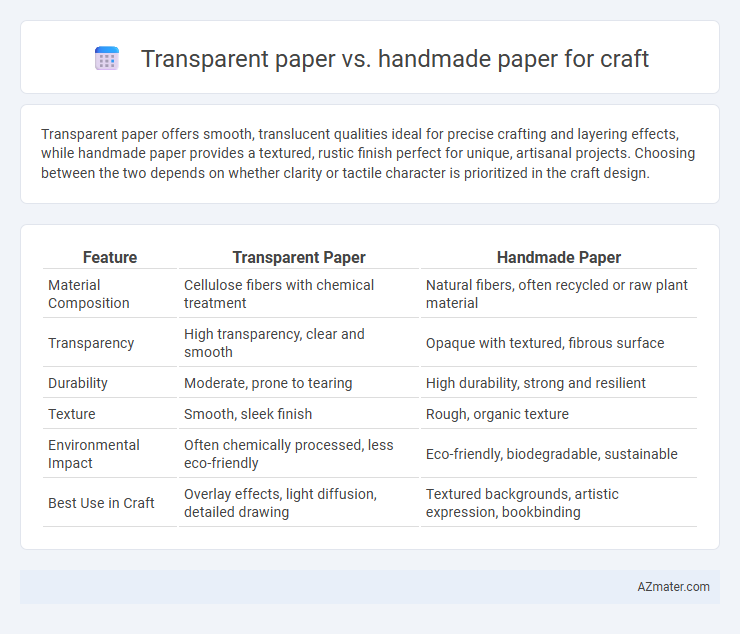Transparent paper offers smooth, translucent qualities ideal for precise crafting and layering effects, while handmade paper provides a textured, rustic finish perfect for unique, artisanal projects. Choosing between the two depends on whether clarity or tactile character is prioritized in the craft design.
Table of Comparison
| Feature | Transparent Paper | Handmade Paper |
|---|---|---|
| Material Composition | Cellulose fibers with chemical treatment | Natural fibers, often recycled or raw plant material |
| Transparency | High transparency, clear and smooth | Opaque with textured, fibrous surface |
| Durability | Moderate, prone to tearing | High durability, strong and resilient |
| Texture | Smooth, sleek finish | Rough, organic texture |
| Environmental Impact | Often chemically processed, less eco-friendly | Eco-friendly, biodegradable, sustainable |
| Best Use in Craft | Overlay effects, light diffusion, detailed drawing | Textured backgrounds, artistic expression, bookbinding |
Introduction to Transparent and Handmade Paper
Transparent paper, also known as tracing paper, is a smooth, thin material made by processing wood pulp or synthetic fibers to achieve high translucency, ideal for detailed craft projects requiring layering or light transmission. Handmade paper is crafted using traditional techniques involving natural fibers such as cotton, hemp, or recycled materials, resulting in textured, unique sheets prized for artistic and eco-friendly crafts. Both paper types serve distinct purposes, with transparent paper favored for precision and clarity while handmade paper offers tactile quality and organic aesthetics.
Key Differences Between Transparent and Handmade Paper
Transparent paper, often made from cellulose fibers, is smooth, thin, and translucent, making it ideal for tracing, overlays, and delicate craft projects requiring light transmission. Handmade paper, produced through traditional methods using recycled fibers or natural materials, features a textured surface, irregular edges, and greater thickness, suited for unique, tactile craft applications like card making and scrapbooking. Key differences include transparency and fiber texture, with transparent paper emphasizing clarity and uniformity, while handmade paper highlights natural fibers and handcrafted individuality.
Material Composition and Production Process
Transparent paper, typically made from cellulose fibers with a bleaching process, offers a smooth, translucent surface ideal for detailed craft projects requiring light transmission. Handmade paper involves natural fibers like cotton, hemp, or recycled materials, processed through traditional pulping and manual sheet-forming methods, resulting in a textured, unique finish with variable thickness. The production process of transparent paper emphasizes uniformity and clarity, while handmade paper focuses on organic texture and sustainability, each influencing its suitability for different craft applications.
Texture and Visual Appeal in Crafts
Transparent paper features a smooth, translucent texture that enhances layering effects and allows light to pass through, creating delicate and ethereal craft designs. Handmade paper offers a unique, rough texture with natural fibers visible, adding a tactile and rustic charm to artistic projects. The visual appeal in crafts depends on the desired effect: transparent paper excels in sleek, modern aesthetics while handmade paper brings warmth and organic character.
Ease of Cutting, Folding, and Shaping
Transparent paper offers superior ease of cutting due to its smooth, consistent texture, allowing precise, clean edges crucial for detailed craft projects. Its flexibility enhances folding and shaping, making it ideal for intricate designs requiring sharp creases and complex forms. Handmade paper, while aesthetically rich with unique textures, often presents challenges in cutting and folding because of its irregular thickness and rough surface, which can cause uneven cuts and difficulty in achieving precise folds.
Compatibility with Various Crafting Techniques
Transparent paper offers excellent compatibility with diverse crafting techniques such as layering, stamping, and embossing due to its smooth, translucent surface that allows light to pass through, enhancing depth and detail. Handmade paper provides a unique texture and organic feel, making it ideal for techniques like painting, collage, and mixed media, where absorbency and tactile quality are essential. Choosing between transparent and handmade paper depends on the desired visual effect and the specific requirements of the craft project.
Color Retention and Paint Absorption
Transparent paper offers minimal paint absorption, allowing vibrant colors to remain sharp and true, making it ideal for projects requiring clear color visibility and layering effects. Handmade paper has higher absorbency, which can cause colors to diffuse and blend, creating softer, more textured finishes but potentially reducing color retention over time. Choosing between transparent and handmade paper depends on the desired balance between precise color vibrancy and artistic paint blending in craft applications.
Durability and Longevity in Finished Products
Transparent paper offers moderate durability in craft projects due to its thin, smooth surface prone to tearing under stress, limiting its longevity in finished products. Handmade paper, by contrast, features a robust fiber composition that enhances its strength, making it more resistant to wear, environmental factors, and aging over time. Crafts created with handmade paper generally exhibit superior durability and longer-lasting aesthetic appeal compared to those made with transparent paper.
Sustainability and Environmental Impact
Transparent paper, often made from cellulose fibers, offers recyclability and biodegradability, making it an eco-friendly choice for sustainable crafts. Handmade paper typically uses recycled fibers and natural materials, reducing waste and promoting resource conservation through artisanal production methods. Both papers support sustainability, but handmade paper generally has a lower carbon footprint due to minimal industrial processing and reliance on renewable resources.
Choosing the Right Paper for Your Craft Project
Choosing the right paper for your craft project depends on texture, durability, and aesthetic appeal. Transparent paper offers smoothness and translucency ideal for layering, tracing, and light-diffusing crafts, while handmade paper provides unique texture, thickness, and natural fibers suited for card-making, scrapbooking, and eco-friendly designs. Consider the project's requirements for flexibility, opacity, and artistic finish to determine whether transparent or handmade paper best enhances your creative outcome.

Infographic: Transparent paper vs Handmade paper for Craft
 azmater.com
azmater.com